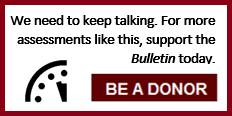Support the Austria pledge
By Seth Baum | January 27, 2015

At the end of the Vienna Conference on the Humanitarian Impact of Nuclear Weapons in December, the Austrian government announced a new pledge that recognizes the risks posed by nuclear weapons and calls on any interested parties, including national governments, to join it in committing to the fight to reduce them. While not perfect, the pledge is smart and timely, and all nations and citizens should support it. Indeed, it has potential to be a major development in addressing nuclear weapon risks.
The Austrian pledge grows out of a broader initiative on the humanitarian impact of nuclear weapons, which has not emerged without controversy. The Vienna Conference is the latest event in this process, which has now spanned about five years. The initiative is motivated largely by the perceived failure of nuclear weapon states to disarm. This perception of failure, held by many non-nuclear weapon states and non-governmental organizations, has created a sharp divide—some call it a crisis—in the Nuclear Non-Proliferation Treaty (NPT), currently the main international institution addressing nuclear disarmament. The NPT is seen as successful at nonproliferation, given that relatively few new countries have built nuclear weapons since it entered into force in 1970. However, the NPT is seen as a failure at disarmament, as the five designated NPT nuclear weapon states (China, France, Russia, the United Kingdom, and the United States) still collectively possess thousands of warheads, with no end to their nuclear weapon programs in sight. Some interpret the humanitarian impacts initiative as an effort by certain parties to take nuclear disarmament into their own hands given the failings of the NPT. This interpretation isn’t completely accurate, though, as in addition to pressuring for disarmament from outside the NPT, the initiative also often seeks to support disarmament within it.
The humanitarian impacts of nuclear weapons initiative follows in the footsteps of successful recent campaigns to ban landmines and cluster munitions, both of which also had their basis in the weapons’ humanitarian consequences. While nuclear weapons play a very different military and political role, all three types of weapons violate international humanitarian law by imposing large, indiscriminate harm on civilian populations. The disarmament campaigns for each of these weapons focused attention on their severe humanitarian consequences to stigmatize their use and possession and build political support for banning them. In contrast, traditional nuclear weapons discourse discusses nuclear weapons in military and security terms.
Thus far, the humanitarian impacts initiative has mainly served as a fact-finding mission aimed at understanding exactly what the humanitarian impacts of nuclear weapons would be, from the deaths and injuries caused by the initial explosions to the global famines caused by the ensuing nuclear winter. But leaders of the initiative have long hinted at going beyond fact-finding to crafting a new treaty banning nuclear weapons, akin to the treaties banning landmines and cluster munitions. Such a treaty would address the perceived failings of the NPT by calling for complete nuclear disarmament at a more rapid pace. The new Austria pledge takes another step towards a ban treaty while also embracing other measures, including measures within the NPT.
The first half of the pledge contains substantive discussion of the facts surrounding nuclear weapons, noting, for example, that a nuclear weapon explosion would have effects that are “potentially threatening the survival of humanity.” This is well stated. Whether humanity would survive has not yet been adequately established. Nor can human extinction be ruled out. The pledge’s phrasing here captures the nuance well.
On the other hand, the pledge goes too far in stating that “it is in the interest of the very survival of humanity that nuclear weapons are never used again, under any circumstances.” To the contrary, humanity’s survival is only threatened by the possibility of large-scale use of nuclear weapons—nuclear war in which many tens or hundreds of weapons are used. Humanity would survive smaller-scale use, as it did following the World War II nuclear bombings or the many subsequent nuclear weapon tests. But the threat to humanity’s survival is not necessary to make the case against small-scale nuclear weapons use, which would nonetheless cause very real humanitarian problems.
The second half of the pledge contains the specifics of the commitments for which Austria is calling. The first of five items is a straightforward promise to report back to “all relevant fora” on the Vienna Conference and to continue working on nuclear weapons issues. The third item is the juiciest, calling for actions to eliminate nuclear weapons. Austria pledges to work on disarmament within the NPT, but also to “fill the legal gap for the prohibition and elimination of nuclear weapons,” which presumably refers to a new ban treaty. Only time will tell exactly how this pledge will be carried out.
The calls for disarmament, both within the NPT and via a possible new ban treaty, are beneficial to the fight to eliminate the nuclear threat. They accomplish several things: They raise the profile of the nuclear disarmament issue, at a time when attention has dangerously faded; they give non-nuclear weapon states and civil society opportunities to contribute, at a time when disarmament issues have become dominated by nuclear weapon states; and above all, they put pressure on nuclear weapon states to disarm, at a time when these nations face important decisions about long-term investments in updating their nuclear weapon systems. Importantly, this pressure will occur even if the nuclear weapon states do not sign a new ban treaty—and indeed, it is expected that they won’t sign, at least not at first. For now, the nuclear weapon states favor a more gradual disarmament process, with the perceived security benefits and risks that come along with it.
The fourth pledge calls for three specific “concrete interim measures to reduce the risk of nuclear weapon detonations.” Each of the measures has advantages and disadvantages that should be carefully weighed. The first measure would have nuclear weapon states put their warheads on lower alert status. This would make it less likely that nuclear weapons would be launched by accident or mistake, but it could also spark dangerous re-alerting processes in crisis situations. The second calls for shifting security doctrines towards lower emphases on nuclear weapons. This makes it less likely that nuclear weapons would be used and thereby paves the way for disarmament, but in doing so it could make war more likely, as countries are more inclined to use other weapons than they are to use nuclear weapons. The third measure calls for rapid nuclear disarmament. This would move the world quickly towards eliminating the weapons, but it could also shift the geopolitical balance of power, in potentially dangerous ways.
For all three of these proposed interim measures, the overall merits would depend on how they were implemented. The Austria pledge does not go into details. The question then is, if the pledge is advanced, how would the details be resolved? One of the nuclear weapon states’ common criticisms of the humanitarian impacts initiative is that, in focusing exclusively on those impacts, it neglects important reasons for not rushing disarmament. There is some truth to this. But the nuclear weapon states are powerful, and the world will hear their reasons for not rushing disarmament. Meanwhile, the humanitarian impacts initiative is quite thoughtful and open to serious debate. If many countries subscribe to the Austria pledge, it will likely prompt a constructive conversation on these interim measures.
There is little downside to the Austria pledge, despite the protests of nuclear weapons states. They complain that the pledge focuses exclusively on the harms of nuclear weapons, ignoring the benefits. They also complain that rapid disarmament puts them and their allies in difficult, perhaps untenable security positions. The complaints are rooted in very real geostrategic and domestic political circumstances and should not be ignored, but should also not be taken as grounds to dial back strong calls for disarmament.
Regarding the overall merits of the Austria pledge, the most important factor is its capacity to build momentum for disarmament and related issues. This momentum has already been a signature accomplishment of the humanitarian impacts of nuclear weapons initiative; the pledge takes it even further. The document is not flawless, but it is good and timely. Its problems are relatively minor and can be sorted out as debate continues. All states and other capable parties should support the pledge.
The views presented here are the author’s views alone, and not those of the Global Catastrophic Risk Institute.
Together, we make the world safer.
The Bulletin elevates expert voices above the noise. But as an independent nonprofit organization, our operations depend on the support of readers like you. Help us continue to deliver quality journalism that holds leaders accountable. Your support of our work at any level is important. In return, we promise our coverage will be understandable, influential, vigilant, solution-oriented, and fair-minded. Together we can make a difference.
Topics: Columnists, Nuclear Weapons














